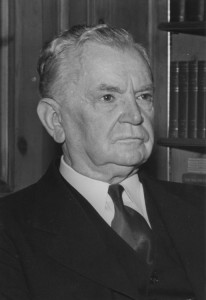This year marks the centenary of the United States’ involvement in World War One. Over the course of twenty months (April 1917-November 2018), the nation mobilized its military, natural resources, industry, and citizens to fight an overseas war in Europe. Realizing that maintaining public morale was critical to achieving victory, the federal government and the state of North Carolina promoted the concepts of patriotism, service, and sacrifice. Here on campus, the students, faculty, and administrators of the North Carolina State Normal and Industrial College (now known as UNC Greensboro) rallied to the cause and enthusiastically supported the war effort. Their activities included: buying Liberty Bonds, training stenographers, making bandages, conserving food, and serving as Red Cross volunteers.
The school was also deeply involved in documenting the contributions of North Carolinians to the war. President Foust sought to both promote and document the school as a leader in war work. For example, President Foust had professional photographs taken of the school’s students canning food, maintaining the grounds on campus, and harvesting crops at its farm. Copies of these photographs were sent to Raleigh as evidence of the institution’s wartime work. Moreover, Dr. Walter Clinton Jackson, head of the State Normal’s Department of History, championed the collecting of information detailing women’s war work on and off campus.
Responding to a July 1917 letter sent by the North Carolina Historical Committee to President Foust requesting that all “materials bearing on the war” be preserved, Dr. Jackson and the History Department took up the call to collect. The History Department published a 1917 pamphlet that made the case for documenting women’s war work. The pamphlet declared that “it is the purpose of the State Normal and Industrial College to make a systematic effort to collect for permanent preservation all the material related to the work of women in this great crisis, so that when the historian who tries to write of woman’s part in the life of former days, he will not lack for ample and correct records.” The pamphlet asks the reader to direct any communication relative to this work directly to “W.C. Jackson, Greensboro, N.C.”
In 1918, Dr. Jackson and the History Department published three additional pamphlets on collecting war-related materials. The first publication “Women and the War in North Carolina: Suggestions for the Collection of Historical Material” was widely circulated amongst students and alumnae. The pamphlet addressed the types of materials found in each of the collecting areas. These collecting areas included: newspaper clippings, official and semi-official documents, manuscript material, pictorial material, educational material, and propaganda. Readers were asked to mail any war-related items to Professor Jackson so that “it may be properly filed and preserved at the State Normal and Industrial College.”
Drawing on the materials received from throughout the state, the second publication, “The State Normal and Industrial College and the War,” detailed the college’s wartime activities that included its work with the Red Cross, the YWCA, food conservation, as well as war-related lectures presented on and off campus. In a lengthy introduction to the pamphlet, President Foust noted that the responsibility of war work should be shouldered by students and faculty since they enjoyed the advantages of a college education. The third publication, “Women and the War in North Carolina” was written by students Mabel Tate and Naomi Neal of the Class of 1918. It reported on the work accomplished by the state’s women from April 1917 to April 1918. Working with Dr. Jackson, the authors of the report summarized the types of women’s war work performed in the areas of fundraising, knitting and sewing, food production, and nursing activities. The pamphlet also listed the types of materials being received at the State Normal.
On November 11, 1918, an Armistice was signed and the fighting on the Western Front ended. When news of the peace reached campus, President Foust allowed students to stage a victory celebration as well as join the citizens of Greensboro for a parade downtown. With the conclusion of the war and demobilization, many individuals and organizations began to look towards peace-time reconstruction. The state of North Carolina recognized the need to formalize and centralize documentation efforts. Legislators felt that these preserved records would serve to honor and commemorate the heroic efforts and sacrifices of its citizens. In 1919, the state’s General Assembly authorized and funded the position of ‘Collector of War Records.” The veteran and educator, Robert House was hired to serve as Collector. To support his efforts, House decided to reactivate and broaden the wartime network of citizen historians.
Not surprisingly, Dr. Walter Clinton Jackson was recruited to help document the homefront mobilization in Guilford County. A committee of “collectors” for Guilford County was formed in 1919. Jackson was selected to serve as the committee’s Chairman. Jackson and the committee developed an ambitious plan to gather documents from local government agencies, civic groups, social organizations, and soldiers. In 1920, Robert House, the state’s “Collector of War Records,” recognized the successful work of Walter Clinton Jackson and his committee. He urged other county collectors to embrace Jackson’s collecting model.
Through the tireless efforts of Professor Walter Clinton Jackson, a substantial number of State Normal records that relate to World War One were preserved. Jackson met and surpassed his charge to preserve materials relating to women’s war work for future historians. Indeed, these records can be found both in the department of Special Collections and University Archives at UNC Greensboro as well as in the North Carolina State Archives in Raleigh.
